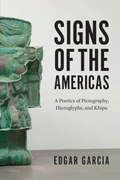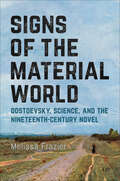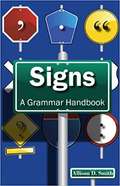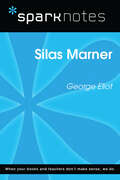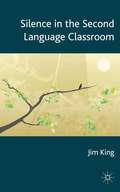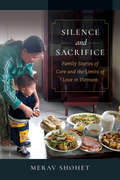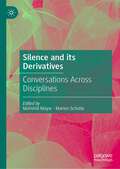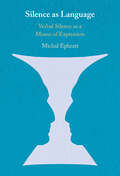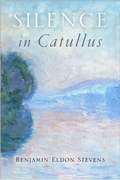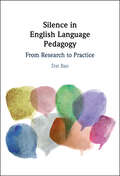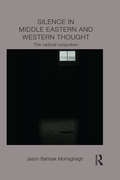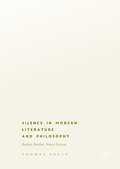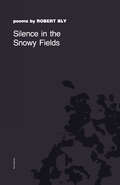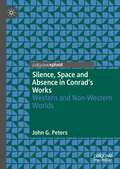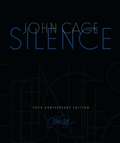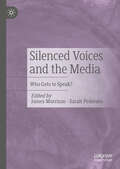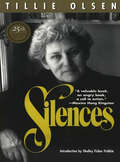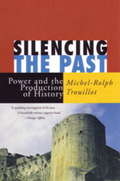- Table View
- List View
Signs of Literature: Language, Ideology and the Literary Text
by Kenneth James HughesThis language primer begins with a suitably esoteric-looking chapter called "The Language of Time. " It isn't until the second paragraph that the unsuspecting reader realizes Hughes is talking about the language of "Time" magazine, which he analyzes as a piece of fiction. Indeed, for Hughes, there is no such thing as a substantive distinction between fiction and non-fiction--there are only texts that do things with structural techniques of syntax and signs. Some of these texts we have commonly agreed to believe are fiction; others we have commonly agreed to believe are fact. None of these texts, however, has anything to do with truth, much less Truth with a capital "T. " In an amazing brief and headlong rush through the history of language from classical Greece to the 20th century, Hughes demonstrates convincingly that neither the empirical world, nor the metaphysical world, has ever informed language. Rather, it is always language which informs the world. Hughes's careful analysis of the techniques of the English language, from Anglo-Saxon verse to the latest post-modern text, constantly reminds us that language is always a made thing, and that the empirical objects captured by language are never immediate, but always mediated by the perception and the craft of the speaker or the author. This book is a must for every serious student of language and literature: because it introduces the reader so effortlessly to the latest vocabulary and techniques of structuralist criticism, it is a basic tool for anyone wishing to communicate his or her ideas to anyone else, and in any discipline. The surprise of the book for the lay reader is that it is so richly entertaining. Its constant demystification of the technique of communication we most take for granted--common speech--offers the reader surprise and delight from the first page to the last.
Signs of the Americas: A Poetics of Pictography, Hieroglyphs, and Khipu
by Edgar GarciaIndigenous sign-systems, such as pictographs, petroglyphs, hieroglyphs, and khipu, are usually understood as relics from an inaccessible past. That is far from the truth, however, as Edgar Garcia makes clear in Signs of the Americas. Rather than being dead languages, these sign-systems have always been living, evolving signifiers, responsive to their circumstances and able to continuously redefine themselves and the nature of the world. Garcia tells the story of the present life of these sign-systems, examining the contemporary impact they have had on poetry, prose, visual art, legal philosophy, political activism, and environmental thinking. In doing so, he brings together a wide range of indigenous and non-indigenous authors and artists of the Americas, from Aztec priests and Amazonian shamans to Simon Ortiz, Gerald Vizenor, Jaime de Angulo, Charles Olson, Cy Twombly, Gloria Anzaldúa, William Burroughs, Louise Erdrich, Cecilia Vicuña, and many others. From these sources, Garcia depicts the culture of a modern, interconnected hemisphere, revealing that while these “signs of the Americas” have suffered expropriation, misuse, and mistranslation, they have also created their own systems of knowing and being. These indigenous systems help us to rethink categories of race, gender, nationalism, and history. Producing a new way of thinking about our interconnected hemisphere, this ambitious, energizing book redefines what constitutes a “world” in world literature.
Signs of the Material World: Dostoevsky, Science, and the Nineteenth-Century Novel
by Melissa FrazierSigns of the Material World traces the literary effects of nineteenth-century materialism that includes the mind and body within a multifaceted “living life.” The book examines a range of scientists, from Auguste Comte and the “vulgar” materialists to Charles Darwin, James Clerk Maxwell, George Henry Lewes, Charles Sanders Peirce, and the Russian Nikolai Strakhov.The book sets Fyodor Dostoevsky in complex opposition to his fellow writers, Lev Tolstoy and Nikolai Chernyshevsky, while also exploring the formal connections that he shares with contemporaries across Europe and the United States, including Wilkie Collins, Charles Dickens, George Eliot, Nathaniel Hawthorne, and Friedrich Schiller. Melissa Frazier argues that Dostoevsky’s art serves as his science, both in his reliance on plot and in his recourse to an often-extravagant figurative language.This combined literary and scientific practice reflects Dostoevsky’s transnational and interdisciplinary reading; it also transforms our own. In George Eliot’s words, Dostoevsky “changes the lights for us.” Once drawn into his orbit, Eliot herself no longer looks quite the same. Finally, Signs of the Material World argues that Eliot and Dostoevsky’s particular strain of nineteenth-century materialism lends itself to an ambivalent political stance, as they both confront the certainties of social utopianism with a deliberate embrace of ambiguity.
Signs: A Grammar Handbook
by Allison D. SmithAllison D. Smith and Fountainhead Press have teamed up to publish Signs: A Grammar Handbook, a low-cost, student-friendly grammar handbook. By focusing on essentials and eliminating wasteful content, such as unused and unwanted support material, we have created a quality textbook that costs half that of comparable offerings.
Silas Marner (SparkNotes Literature Guide Series)
by SparkNotesSilas Marner (SparkNotes Literature Guide) by George Eliot Making the reading experience fun! Created by Harvard students for students everywhere, SparkNotes is a new breed of study guide: smarter, better, faster. Geared to what today's students need to know, SparkNotes provides: *Chapter-by-chapter analysis *Explanations of key themes, motifs, and symbols *A review quiz and essay topicsLively and accessible, these guides are perfect for late-night studying and writing papers
Silence In The Second Language Classroom
by Jim KingWhy are second language learners in Japan's universities so silent? This book investigates the perplexing but intriguing phenomenon of classroom silence and draws on ideas from psychology, sociolinguistics and anthropology to offer a unique insight into the reasons why some learners are either unable or unwilling to speak in a foreign language.
Silence and Beauty: Hidden Faith Born of Suffering
by Makoto Fujimura2017 Logos Bookstore Association Award for Christianity/Culture2017 Dallas Willard Center Book Award FinalistForeword INDIES 2016 Book of the Year Awards FinalistWorld Magazine's Best Books of 2016 Short List2016 Aldersgate Prize by the John Wesley Honors College at Indiana Wesleyan UniversityEvangelical Christian Publishers Association Top Shelf Book Cover Award14th Annual Outreach Magazine Resource of the Year, Counseling and RelationshipsMissio Alliance Essential Reading List of 2016
Silence and Sacrifice: Family Stories of Care and the Limits of Love in Vietnam
by Merav ShohetHow do families remain close when turbulent forces threaten to tear them apart? In this groundbreaking book based on more than a decade of research set in Vietnam, Merav Shohet explores what happens across generations to families that survive imperialism, war, and massive political and economic upheaval. Placing personal sacrifice at the center of her story, Shohet recounts vivid experiences of conflict, love, and loss. In doing so, her work challenges the idea that sacrifice is merely a blood-filled religious ritual or patriotic act. Today, domestic sacrifices—made largely by women—precariously knot family members together by silencing suffering and naturalizing cross-cutting gender, age, class, and political hierarchies. In rethinking ordinary ethics, this intimate ethnography reveals how quotidian acts of sacrifice help family members forge a sense of continuity in the face of trauma and decades of dramatic change.
Silence and Subject in Modern Literature: Spoken Violence
by Ulf OlssonWhy does interrogation silence its object and not make it speak? Silence vs speech is a central issue in classical and modern literary works. This book studies literary representations of the power relations in which we are forced to speak using a range of texts ranging from the modern crime novel, via classics, to avant-garde plays.
Silence and its Derivatives: Conversations Across Disciplines
by Mahshid Mayar Marion SchulteThis edited book examines silence and silencing in and out of discourse, as viewed through a variety of contexts such as historical archives, day-to-day conversations, modern poetry, creative writing clubs, and visual novels, among others. The contributions engage with the historical shifts in how silence and silencing have been viewed, conceptualized and recorded throughout the course of the twentieth and twenty-first centuries, then present a series of case studies from disciplines including linguistics, history, literature and culture, and geographical settings ranging from Argentina to the Philippines, Nigeria, Ireland, Morocco, Japan, South Africa, and Vietnam. Through these examples, the authors underline the thematic and methodological contact zones between different fields and traditions, providing a stimulating and truly interdisciplinary volume that will be of interest to scholars across the humanities.
Silence as Language: Verbal Silence as a Means of Expression
by Michal EphrattVerbal silence touches on every possible aspect of daily life. This book provides a full linguistic analysis of the role of silence in language, exploring perspectives from semantics, semiotics, pragmatics, phonetics, syntax, grammar and poetics, and taking into account a range of spoken and written contexts. The author argues that silence is just as communicative in language as speech, as it results from the deliberate choice of the speaker, and serves functions such as informing, conveying emotion, signalling turn switching, and activating the addresser. Verbal silence is used, alongside speech, to serve linguistic functions in all areas of life, as well as being employed in a wide variety of written texts. The forms and functions of silence are explained, detailed and illustrated with examples taken from both written texts and real-life interactions. Engaging and comprehensive, this book is essential reading for anyone interested in this fascinating linguistic phenomenon.
Silence in Catullus
by Benjamin Eldon StevensBoth passionate and artful, learned and bawdy, Catullus is one of the best-known and critically significant poets from classical antiquity. An intriguing aspect of his poetry that has been neglected by scholars is his interest in silence, from the pauses that shape everyday conversation to linguistic taboos and cultural suppressions and the absolute silence of death. In "Silence in Catullus," Benjamin Eldon Stevens offers fresh readings of this Roman poet's most important works, focusing on his purposeful evocations of silence. This deep and varied "poetics of silence" takes on many forms in Catullus's poetic corpus: underscoring the lyricism of his poetry; highlighting themes of desire, immortality-in-culture, and decay; accenting its structures and rhythms; and, Stevens suggests, even articulating underlying philosophies. Combining classical philological methods, contemporary approaches to silence in modern literature, and the most recent Catullan scholarship, this imaginative examination of Catullus offers a new interpretation of one of the ancient world's most influential and inimitable voices.
Silence in English Language Pedagogy: From Research to Practice
by Dat BaoSilence in language learning is commonly viewed negatively, with language teachers often struggling to interpret learner silence and identify whether it is part of communication, mental processing, or low engagement. This book addresses silence in language pedagogy from a positive perspective, translating research into practice in order to inform teaching and to advocate greater use of positive silence in the classroom. The first half of the book examines the existing research into silence, and the second half provides research-informed practical strategies and classroom tasks. It offers applicable principles for task design that utilises rich resources, which include visual arts, mental representation, poetry, music, and other innovative tools, to allow both silence and speech to express their respective and interrelated roles in learning. Comprehensive yet accessible, it is essential reading for academic researchers and students in applied linguistics, TESOL, and language teaching, as well as for language teachers and educators.
Silence in Middle Eastern and Western Thought: The Radical Unspoken (Intersections: Colonial and Postcolonial Histories)
by Jason Bahbak MohagheghPresenting an engaging reflection on the work of prominent modern Iranian literary artists in exchange with contemporary Continental literary criticism and philosophy, this book tracks the idea of silence – through the prism of poetics, dreaming, movement, and the body – across the textual imaginations of both Western and Middle Eastern authors. Through this comparative nexus, it explores the overriding relevance of silence in modern thought, relating the single concept of "the radical unspoken" to the multiple registers of critical theory and postcolonial writing. In this book, the theoretical works of Georges Bataille, Maurice Blanchot, Gaston Bachelard, Antonin Artaud, and Gilles Deleuze are placed into a charged global dialogue with the literary-poetic writings of Sadeq Hedayat, Ahmad Shamlu, Nima Yushij, Esmail Kho’i, and Forugh Farrokhzad. It also examines a vast spectrum of thematic dimensions including disaster, exhaustion, eternity, wandering, insurrection, counter-history, abandonment, forgetting, masking, innocence, exile, vulnerability, desire, excess, secrecy, formlessness, ecstasy, delirium, and apocalypse. Providing comparative criticism that traces some of the most compelling intersections and divergences between Western and Middle Eastern thought, this book is of interest to academics of modern Persian literature, postcolonial studies, Continental philosophy, and Middle Eastern studies.
Silence in Modern Literature and Philosophy: Beckett, Barthes, Nancy, Stevens
by Thomas GouldThis book discusses the elusive centrality of silence in modern literature and philosophy, focusing on the writing and theory of Jean-Luc Nancy and Roland Barthes, the prose of Samuel Beckett, and the poetry of Wallace Stevens. It suggests that silence is best understood according to two categories: apophasis and reticence. Apophasis is associated with theology, and relates to a silence of ineffability and transcendence; reticence is associated with phenomenology, and relates to a silence of listenership and speechlessness. In a series of diverse though interrelated readings, the study examines figures of broken silence and silent voice in the prose of Samuel Beckett, the notion of shared silence in Jean-Luc Nancy and Roland Barthes, and ways in which the poetry of Wallace Stevens mounts lyrical negotiations with forms of unsayability and speechlessness.
Silence in the Quagmire: The Vietnam War in U.S. Comics (Encapsulations: Critical Comics Studies)
by Harriet E. EarleIn Silence in the Quagmire Harriet E. H. Earle uses silence to construct a narrative of the Vietnam War via U.S. comics. Unlike the vast majority of cultural artifacts and scholarly works about the war, which typically focus on white, working-class American servicemen and their experiences of combat, Earle&’s work centers less-visible players: the Vietnamese on both sides of the conflict, women and girls, and returning veterans. Earle interrogates the ways this conflict is represented in American comic books, with special focus on these missing groups. She discusses how—and more critically why—these groups are represented as they are, if they&’re represented at all, and the ways these representations have affected views of the war, during and since. Using Michel Foucault&’s understanding of silence as discourse, Earle considers how both silence and silencing are mobilized in the creation of the U.S.-centric war narrative. Innovative in its structure and theoretical scaffolding, Silence in the Quagmire deepens our understanding of how comic books have represented the violence and trauma of conflict.
Silence in the Snowy Fields: Poems (Wesleyan Poetry Series)
by Robert BlyStriking and moving poems that are rooted deep in the earth The poems of Robert Bly are rooted deep in the earth. Snow and sunshine, barns and cornfields and cars on the empty nighttime roads, abandoned Minnesota lakes and the mood of America now—these are his materials. He sees and talks clearly: he uses no rhetoric nor mannered striving for effect, but instead the simple statement that in nine lines can embody a mood, reveal a profound truth, illuminate in an important way the inward and hidden life. This is a poet of the modern world, thoroughly aware of the complexities of the moment but equally mindful of the great stream of life—all life—of which mankind is only a part.
Silence, Space and Absence in Conrad's Works: Western and Non-Western Worlds
by John G. PetersThis book considers the relationship between sound and silence in the works of Joseph Conrad, along with their ties to Western and non-Western space. Throughout Conrad’s works, a pattern emerges where Western space is associated with sound and non-Western space is associated with silence; similarly, Western space is portrayed as full of objects and activity, whereas non-Western space is portrayed as empty. As these tales progress, though, Conrad’s characters embark on transformational journeys that cause them to reassess the world they live in and sometimes even the nature of the universe. These journeys invariably occur through encountering non-Western space, and during the course of these journeys, the dichotomy between Western space, perceived as replete with sound and activity, and non-Western space, empty of such, blurs such that the fullness of the West is revealed to be simply a surface hiding the emptiness beneath. In the end, both Western and non-Western space are revealed to be absences, as the absence of sound becomes a correlative for the emptiness of space and the emptiness of space becomes a metonym for the cosmological emptiness of nothingness.
Silence: A Thirteenth-Century French Romance
by Sarah Roche-MahdiThis bilingual edition, a parallel text in Old French and English, is based on a reexamination of the Old French manuscript and makes Silence available to specialists and students in various fields of literature and women's studies. <p><p>The Roman de Silence, an Arthurian romance of the thirteenth century, tells of a girl raised as a boy, equally accomplished as a minstrel and knight, whose final task, the capture of Merlin, leads to her unmasking.
Silence: Lectures and Writings (50th Anniversary Edition)
by John Cage Kyle GannSilence, John Cage's first book and epic masterpiece, was published in October 1961. In these lectures, scores, and writings, Cage tries, as he says, to find a way of writing that comes from ideas, is not about them, but that produces them. Often these writings include mesostics and essays created by subjecting the work of other writers to chance procedures using the I Ching. Fifty years later comes a beautiful new edition with a foreword by eminent music critic Kyle Gann. A landmark book in American arts and culture, Silence has been translated into more than forty languages and has sold over half a million copies worldwide. Wesleyan University Press is proud to celebrate the fiftieth anniversary of the book's publication with this special hardcover edition.
Silenced Voices and the Media: Who Gets to Speak?
by James Morrison Sarah PedersenThis edited collection delves into the multifaceted theme of 'Silenced Voices,' showcasing a diverse array of perspectives from scholars around the globe. From historical reflections to contemporary analyses, the book examines the complex dynamics of voice suppression and enablement across different media landscapes. Divided into four thematic sections, the chapters explore the challenges faced by marginalized and mainstream voices alike. From the portrayal of silenced narratives in the news media to the representation of underrepresented groups in cultural production, the collection spans a wide spectrum of issues. Authors employ varied methodological approaches to investigate the silencing of voices in the realms of politics, society, and professional media practices. Offering fresh insights and critical reflections, this volume serves as a timely contribution to ongoing debates surrounding freedom of expression, fake news, and the complexities of contemporary media environments.
Silences
by Tillie OlsenThis book is about silences pertaining to literature. Literary criticism from a feminist perspective. Navigating the spaces in the canon where issues of race, class, and gender have been silenced.
Silences
by Tillie OlsenA landmark survey of disenfranchised literary voices and the forces that seek to silence them—from the influential activist and author of Tell Me a Riddle. With this groundbreaking work, Olsen revolutionized the study of literature by shedding critical light on the writings of marginalized women and working-class people. From the excavated testimony of authors&’ letters and diaries, Olsen shows us the many ways the creative spirit, especially in those disadvantaged by gender, class, or race, has been suppressed through the years. Olsen recounts the torments of Herman Melville, the shame that brought Willa Cather to a dead halt, and the struggles of Olsen&’s personal heroine Virginia Woolf, the greatest exemplar of a writer who confronted the forces that worked to silence her. First published in 1978, Silences expanded the literary canon and the ways readers engage with literature. This 25th-anniversary edition includes Olsen&’s classic reading lists of forgotten authors and a new introduction. Bracing and prescient, Silences remains &“of primary importance to those who want to understand how art is generated or subverted and to those trying to create it themselves&” (Margaret Atwood, The New York Times Book Review). &“A valuable book, an angry book, a call to action.&” —Maxine Hong Kingston &“Silences helped me to keep my sanity many a day.&” —Gloria Naylor, author of Mama Day &“[Silences is] &‘the Bible.&’ I constantly return to it.&” —Sandra Cisneros, author of The House on Mango Street &“Silences will, like A Room of One&’s Own, be quoted where there is talk of the circumstances in which literature is possible.&” —Adrienne Rich, author of Diving into the Wreck
Silencing the Past: Power and the Production of History
by Michel-Rolph TrouillotPlacing the West's failure to acknowledge the most successful slave revolt in history alongside denials of the Holocaust and the debate over the Alamo, Michel-Rolph Trouillot offers a stunning meditation on how power operates in the making and recording of history.

